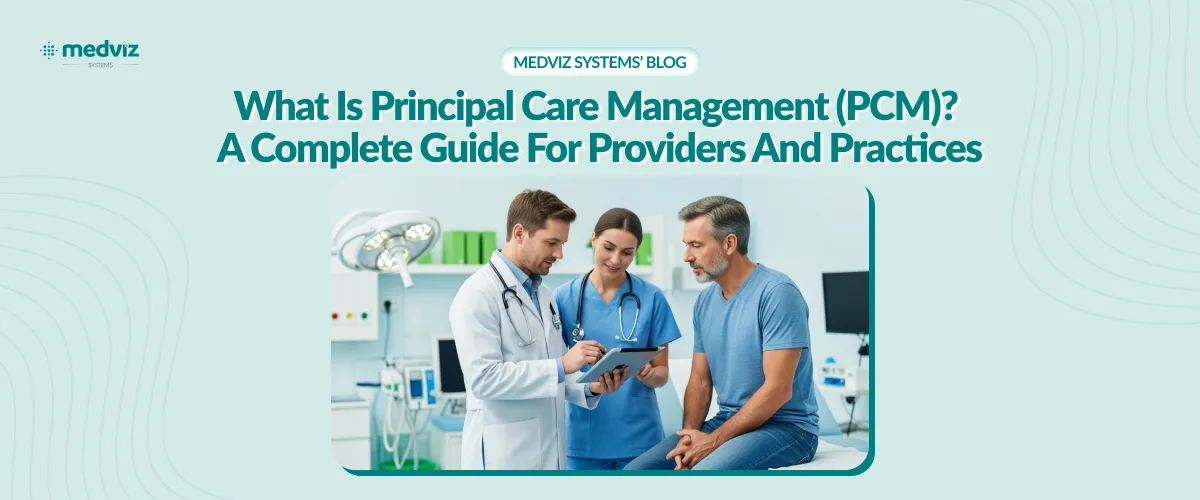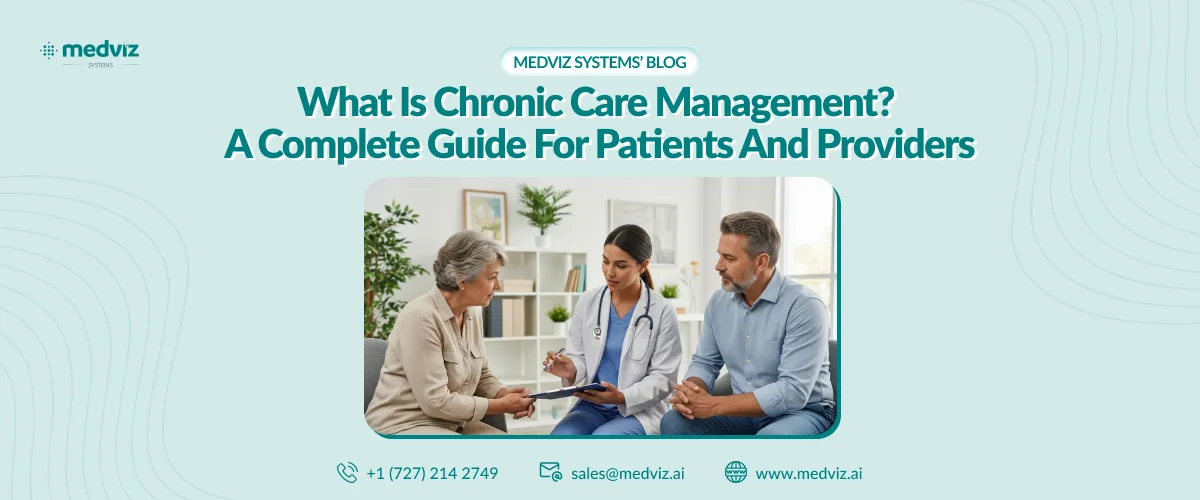For many Medicare patients, a single chronic illness drives most hospitalizations, costs, and health risks. Think of a patient with advanced congestive heart failure, severe COPD, or complicated diabetes—their care revolves almost entirely around managing that one condition.
Until recently, providers had limited reimbursement options for the intensive work required in these cases. That’s why the Centers for Medicare & Medicaid Services (CMS) introduced Principal Care Management (PCM).
PCM allows providers to deliver and bill for care management services focused on one serious, high-risk chronic condition. For practices, PCM offers both a way to improve outcomes for vulnerable patients and to generate sustainable revenue aligned with value-based care.
This guide explains:
- What PCM is and how it differs from Chronic Care Management (CCM)
- Eligibility rules for patients and providers
- CPT codes and billing requirements
- Implementation workflows
- Benefits, challenges, and future trends
What Is Principal Care Management (PCM)?
Principal Care Management (PCM) is a Medicare-recognized service for patients with one serious, high-risk chronic condition that requires ongoing management for at least three months.
Core PCM Services Include:
- Developing and updating a disease-specific care plan
- Monitoring symptoms, labs, and medications
- Coordinating with specialists and other providers
- Managing care transitions (e.g., hospital to home)
- Educating patients and caregivers
Why CMS created PCM:
- To fill the gap left by Chronic Care Management, which requires two or more conditions
- To reimburse providers for work already being done with high-risk patients
- To reduce avoidable hospitalizations and improve patient outcomes
PCM vs. Chronic Care Management (CCM): Key Differences
PCM and CCM are similar, but they serve different patient populations.
| Feature | PCM | CCM |
| Conditions required | 1 serious chronic condition | 2+ chronic conditions |
| Duration | ≥ 3 months | ≥ 12 months (or until death) |
| Risk level | Significant risk of hospitalization, decline, or death | Risk from multiple chronic conditions |
| Billing codes | 99424–99427 | 99490, 99439, 99491, 99487, 99489 |
| Care plan | Disease-specific | Comprehensive across conditions |
When to use PCM: For patients where one illness clearly dominates their care needs (e.g., heart failure, ESRD, advanced cancer).
When to use CCM: For patients managing multiple interrelated chronic conditions.
Who Qualifies for Principal Care Management?
Patient Eligibility
Patients must meet all of the following criteria:
- One chronic condition expected to last at least three months
- Condition places them at significant risk of hospitalization, decline, or death
- Requires intensive, ongoing management
- Patient provides informed consent (verbal or written)
Examples: COPD, heart failure, ESRD, complicated diabetes, Parkinson’s disease.
Provider Eligibility
PCM services may be billed by:
- Physicians (MD/DO)
- Nurse practitioners (NPs)
- Physician assistants (PAs)
- Clinical nurse specialists (CNSs)
- Clinical staff under direct supervision (specific codes)
Compliance Tip: Select patients carefully to ensure the condition meets CMS’s criteria—this reduces audit risk.
PCM CPT Codes and Billing Guidelines
Accurate coding is essential to maximize reimbursement and remain compliant.
Current PCM CPT Codes (2025)
- 99424 – First 30 minutes by physician/QHP per month
- 99425 – Each additional 30 minutes by physician/QHP
- 99426 – First 30 minutes by clinical staff (under supervision)
- 99427 – Each additional 30 minutes by clinical staff (under supervision)
Billing Rules
- Document at least 30 minutes per patient per month
- Only one provider may bill PCM per patient per month
- PCM cannot be billed with CCM or overlapping codes in the same month
- Documentation must include:
- Consent form
- Care plan details
- Time logs with date, activity, and staff/provider name
- Supervision details (when clinical staff are involved)
Reimbursement Snapshot
- $90–$100 average Medicare reimbursement for 99424 (rates vary by locality)
- Staff-based codes reimburse at slightly lower rates
- Additional 30-minute increments increase total reimbursement
How to Implement PCM in Your Practice
Launching PCM requires structured workflows, staff training, and patient engagement strategies.
Step-by-Step Workflow
- Identify eligible patients via EHR data or specialist referrals
- Obtain patient consent and explain benefits and costs
- Develop a care plan tailored to the single condition
- Deliver ongoing management with check-ins, monitoring, and plan updates
- Coordinate with other providers across care settings
- Document thoroughly and bill monthly
Staffing Considerations
- Physicians/QHPs: Handle complex decisions and oversight
- Clinical staff: Manage education, monitoring, coordination
- Admin team: Oversee billing, compliance, and audit readiness
Benefits of Principal Care Management
For Patients
- Improved management of high-risk conditions
- Fewer avoidable hospitalizations and ER visits
- More proactive communication with providers
- Personalized, evolving care plans
For Providers
- Reimbursement for services already being delivered
- Stronger patient-provider relationships
- Alignment with value-based care and population health initiatives
- Opportunity to integrate with Remote Patient Monitoring (RPM)
Data point: CMS reports that 90% of Medicare spending goes toward chronic disease management. PCM helps reduce costs by addressing high-impact conditions.
Challenges and Solutions in Delivering PCM
Challenge 1: Documentation burden
- Solution: Standardize EHR templates and automate time tracking
Challenge 2: Patient consent & engagement
- Solution: Train staff to clearly explain benefits and cost-sharing
Challenge 3: Staffing limitations
- Solution: Leverage nurses and care coordinators under supervision
Challenge 4: Compliance risks
- Solution: Maintain detailed time logs, avoid overlapping billing with CCM
Challenge 5: Technology barriers
- Solution: Use care management platforms that integrate with your EHR
The Future of Principal Care Management
PCM is evolving beyond a standalone service and becoming integral to value-based care.
Key Trends
- Advanced Primary Care Management (APCM): PCM bundled into broader monthly payments
- Telehealth and RPM Integration: Enables real-time monitoring and intervention
- Specialist Adoption: Cardiology, pulmonology, endocrinology, and nephrology practices leading adoption
- Technology & AI: Predictive analytics to identify patients most likely to benefit
🔮 By 2030, PCM will likely become standard practice in chronic disease management, integrated with broader population health strategies.
Conclusion
Principal Care Management (PCM) empowers providers to better manage patients whose health is dominated by a single chronic illness. By adopting PCM, practices can:
- Deliver higher-quality, coordinated care
- Improve outcomes and patient satisfaction
- Unlock new reimbursement opportunities
- Strengthen their position in value-based care models
Ready to Maximize Your PCM Reimbursement?
Start optimizing your Principal Care Management billing today by reviewing your documentation, ensuring accurate CPT coding, and applying best practices to minimize denials while boosting reimbursement.
📞 Want expert guidance? Call +1 (727) 214-2749 or email sales@medviz.ai to schedule a consultation and learn how to streamline your PCM program for maximum results.


Leave a Reply